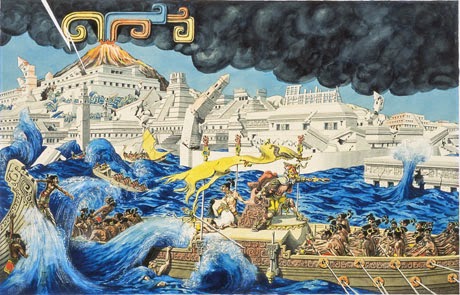 |
| Athenian Predemocracy |
Ancient Athens underwent a series of governments and reforms before it became the well-known democratic city-state that epitomized the ideals and the culture of ancient Greece. During the Archaic Period, a historical time period lasting from 8000 to 1000 b.c.e., Athens was a city-state governed by a king, known as a basileus.
Due to Athens’s geographic position on a beautiful harbor surrounded by agriculturally rich lands, the city was able to resist invasion and to maintain and expand its influence. As Athens’s trade and influence expanded, the king’s powers diminished. The Areopagus, a council of Athenian nobles, slowly usurped the king’s power.
The council, called Areopagus for the name of the hill upon which they met, was filled with nobles who gained wealth and influence from controlling the city’s wine and olive oil markets. With their increased wealth they were able to exert more influence over Athens and the king.
  |
Over time Athens became a de facto oligarchy, consisting of the Areopagus and nine elected rulers, known as archons, who were selected by the Areopagus. The archons tended to all matters of state but always had to receive approval for their decisions and actions from the Areopagus. Upon the end of their term archons became members of the Areopagus.
Since rule was controlled by the wealthy, Athenian government ineffectively addressed the issues facing commoners. Since members of the Areopagus dominated olive oil and wine production, everyday wheat farmers were unable to break into these markets. Eventually, wheat prices dropped as Athens began to trade for cheaper wheat, leaving Athenian farmers in debt and often in partial slavery.
With the city-state ripe for reform, prominent Athenians and members of the Areopagus agreed to appoint a dictator in order to reform the government and the economy. Together, they selected Solon, a prominent Athenian lawmaker, poet, and former archon. Solon voided outstanding debts, freed many Athenians from slavery, banned slavery loans, and promoted wine and olive production by common farmers.
In the constitution that he created Solon established a four-tier class structure. The top two tiers, based on wealth, were able to serve on the Areopagus, while the third class was able to serve on an elected council of 400 citizens, if selected. This council effectively acted as a check upon the Areopagus.
The lowest class was permitted to assemble and to elect some local leaders. Judicial courts were reformed, and trial by jury was introduced. As soon as the constitution was finalized Solon gave control of the government back to the Areopagus.
Although the overwhelming majority of Athenians praised his governmental reforms, Solon failed to improve the economy. Peisistratus, a military general, took control and began reforming not just the economy but also religion and culture. He supported Solon’s constitution, as long as his supporters were chosen.
Upon his death Peisistratus’s son, Hippias, was unable to maintain control, and the Athenian ruler was overthrown by Sparta, whose government placed their own supporters in Athenian posts. The Spartans selected Isagoras to lead Athens, but he began disenfranchising too many Athenians, leading to rebellion.
Opposed by Cleisthenes, Isagoras was eventually forced to flee. Cleisthenes enfranchised all free men in Athens and the surrounding areas and reformed the government, allowing all male citizens to participate and to vote for a council made up of elected male citizens over the age of 30.
In order to ensure that ambitious Athenians were controlled, the council was allowed to “ostracize” citizens by majority vote, banishing them from Athens for at least 10 years. With these reforms Cleisthenes effectively engineered Athens’s transition to democracy.